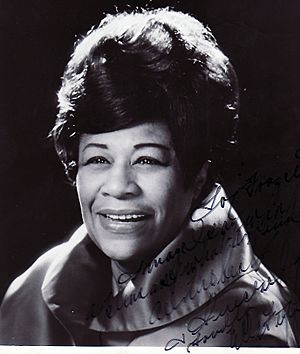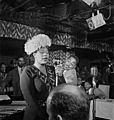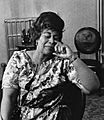Ella Fitzgerald facts for kids
Quick facts for kids
Ella Fitzgerald
|
|
|---|---|
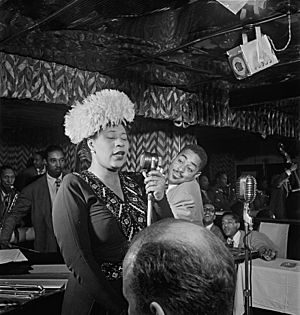
Ella in 1947
|
|
| Background information | |
| Birth name | Ella Jane Fitzgerald |
| Born | April 25, 1917 Newport News, Virginia, U.S. |
| Died | June 15, 1996 (aged 79) Beverly Hills, California, U.S. |
| Genres | Ballads, swing, traditional pop, vocal jazz |
| Occupation(s) | singer |
| Instruments | voice |
| Years active | 1934–1993 |
| Labels | Capitol, Decca, Pablo, Reprise, Verve |
Ella Jane Fitzgerald (April 25, 1917 – June 15, 1996) was an amazing American jazz singer. People called her "Lady Ella," the "Queen of Jazz," and the "First Lady of Song."
Her voice was incredible, covering three octaves. This meant she could sing very high and very low notes. She was also famous for her special way of singing called scat singing, where she used her voice to make sounds like musical instruments. Ella won 14 Grammy Awards. She also received important honors like the National Medal of Art and the Presidential Medal of Freedom.
Contents
Ella's Early Life
Ella Fitzgerald was born in 1917 in Newport News, Virginia, United States. Her parents were William and Temperance "Tempie" Fitzgerald. When Ella was very young, her parents separated. She then moved to Yonkers, New York to live with her mother and her mother's boyfriend, Joseph Da Silva. In 1923, Ella's half-sister, Frances Da Silva, was born.
As a child, Ella dreamed of becoming a dancer. She loved listening to jazz music. Her favorite singers were Louis Armstrong, Bing Crosby, and especially Connee Boswell from The Boswell Sisters. Ella once said, "My mother brought home one of her records, and I fell in love with it....I tried so hard to sound just like her."
In 1932, Ella's mother passed away. After this, Ella faced some difficult times. She struggled in school and was sent to a special school. She later left this school and was without a home for a while.
Ella got her first chance to sing when she was 17. It was on November 21, 1934, at the Harlem Opera House in Harlem, New York. She entered a famous "Amateur Night" contest. At first, she planned to dance. But she felt nervous because of other dancers. So, she decided to sing instead. She sang two songs by Connee Boswell, "Judy" and "The Object of My Affection." Ella won first prize, which was US$25!
Singing with Big Bands
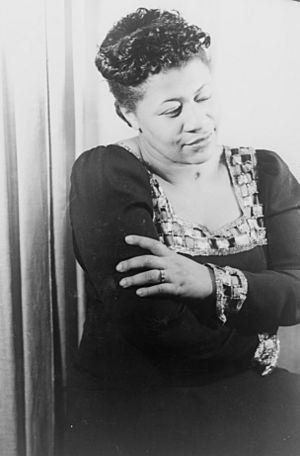
In January 1935, Ella won a chance to perform for a week with the Tiny Bradshaw band. This was also at the Harlem Opera House. There, she met a drummer and bandleader named Chick Webb. Webb already had a singer, so he wasn't sure about hiring Ella. He thought she looked a bit awkward and messy. But Webb let her try singing with his band at a dance at Yale University.
Ella started singing regularly with Webb's Orchestra in 1935. They often performed at Harlem's famous Savoy Ballroom. She recorded several hit songs with them. These included "Love and Kisses" and " (If You Can't Sing It) You'll Have to Swing It (Mr. Paganini)". In 1938, she helped write and sang a popular version of the nursery rhyme, "A-Tisket, A-Tasket". This song made her very famous.
Chick Webb sadly passed away on June 16, 1939. His band was then renamed "Ella Fitzgerald and her Famous Orchestra." Ella became the leader of the band. She recorded nearly 150 songs during her time with the orchestra.
Becoming a Solo Star
In 1942, Ella left the band to become a solo singer. She signed with Decca Records. She had many popular hit songs on this label. She also recorded with other great musicians like the Ink Spots, Louis Jordan, and the Delta Rhythm Boys.
Milt Gabler from Decca became her manager. She also started working often with jazz producer Norman Granz. She frequently sang at his Jazz at the Philharmonic concerts. Later, Granz became her main manager.
In the mid-1940s, jazz music began to change. A new style called bebop became popular. Ella changed her singing style to fit this new sound. She worked with Dizzy Gillespie's big band. She started using scat singing much more in her performances. Ella said about singing with Gillespie, "I just tried to do [with my voice] what I heard the horns in the band doing."
Her 1945 scat recording of "Flying Home" was very important. The New York Times called it "one of the most influential vocal jazz records of the decade." They said that while other singers like Louis Armstrong had tried similar improvisation, no one used the technique with such amazing creativity before Ella. Her be-bop recording of "Oh, Lady be Good!" (1947) was also a big hit. It made people see her as one of the most important jazz singers.
Norman Granz didn't like some of the songs Ella was given to record at Decca. So, in her last years with Decca, she recorded some duets with pianist Ellis Larkins. These were released in 1950 as Ella Sings Gershwin.
Singing with Verve Records
In 1955, Ella left Decca Records. She joined Norman Granz's new record label, Verve Records. She later explained, "I had gotten to the point where I was only singing bebop. I thought bebop was 'it'... But it finally got to the point where I had no place to sing. I realized then that there was more to music than bop. Norman... felt that I should do other things, so he produced The Cole Porter Songbook with me. It was a turning point in my life."
Her new album, Ella Fitzgerald Sings the Cole Porter Songbook, came out in 1956. This was the first of eight "Songbook" albums she would record for Verve between 1956 and 1964. These albums featured many classic songs. Ella wanted to reach a wider audience, not just jazz fans.
Ella Fitzgerald Sings the Duke Ellington Songbook was special. It was the only "Songbook" album where the composer, Duke Ellington, also played with her. Duke Ellington and Billy Strayhorn played on half of the album's 38 songs. They even wrote two new songs for the album.
The "Songbook" series became Ella's most famous and praised work. The New York Times wrote in 1996 that these albums were among the first pop records to focus so much on individual songwriters. They helped show that pop albums could be used for serious musical exploration.
Ella Fitzgerald also recorded albums of songs by Cole Porter and George Gershwin in 1972 and 1983. These were called Ella Loves Cole and Nice Work If You Can Get It. Later, she recorded another album of songs by one composer, Ella Abraça Jobim, with songs by Antonio Carlos Jobim.
While recording the "Songbooks" and other studio albums, Ella toured a lot. She performed 40 to 45 weeks each year in the United States and around the world with Norman Granz. Granz helped her become one of the most important live jazz performers.
In the mid-1950s, Ella made history. She became the first African-American artist to perform at the Mocambo, a famous Hollywood nightclub. This happened because Marilyn Monroe convinced the owner to book Ella. This was a very important moment in Ella's career.
Some of her live albums from Verve are also highly praised by critics. These include Ella at the Opera House, Ella in Rome, and Ella in Berlin.
Later Years and Legacy
In her later life, Ella Fitzgerald continued to perform often. However, her health began to get worse. She had heart surgery in 1986. She also had diabetes, which affected her eyesight. Her diabetes became very serious, leading to severe problems with her legs. She never fully recovered and could not perform as much. She spent more time with her family.
Ella Fitzgerald passed away at her home in Beverly Hills, California on June 15, 1996. She was buried in the Sunset Mission Mausoleum at Inglewood Park Cemetery in Inglewood, California.
Awards and Honors
By the 1990s, Ella Fitzgerald had recorded over 200 songs. In 1991, she gave her very last concert at Carnegie Hall. She had performed there 26 times throughout her career.
Ella received many awards for her amazing talent. In 1979, she received Kennedy Center Honors. In 1987, she was given the National Medal of Arts. She also received the Presidential Medal of Freedom. France honored her with the Commander of Arts and Letters award. Important schools like Yale University and Dartmouth gave her honorary doctorate degrees.
Many of Ella's awards, personal items, and documents were given to important places. These include the Smithsonian Institution, the library at Boston University, the Library of Congress, and the Schoenberg Library at UCLA.
Ella's Personal Life
In 1941, Ella Fitzgerald married Benny Kornegay. Their marriage ended after two years. In December 1947, she married double bass player Ray Brown. They adopted a child of Ella's half-sister, Frances. They named him Ray Brown, Jr.. Ella and Ray Brown divorced in 1953.
In July 1957, news reports said that Ella had secretly married Thor Einar Larsen, a young man from Norway, in Oslo. This relationship quickly ended.
Images for kids
-
A young Fitzgerald, photographed by Carl Van Vechten in January 1940
-
Fitzgerald with Dizzy Gillespie, Ray Brown, Milt Jackson, and Timme Rosenkrantz in New York City, 1947.
-
Fitzgerald performing at the Helsinki Culture Hall in Helsinki, Finland, in April 1963
-
Fitzgerald shakes hands with President Ronald Reagan after performing in the White House, 1981
-
Fitzgerald in 1960 by Erling Mandelmann
See also
 In Spanish: Ella Fitzgerald para niños
In Spanish: Ella Fitzgerald para niños


